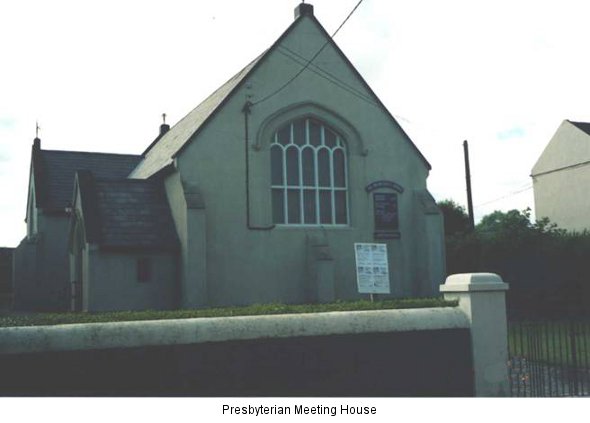Journal Volume 3 2000
Places of Worship in Greystones (continued/3)
The Presbyterian Meeting-House
As we stand at the entrance gates on Trafalgar Road, we can see the year '1887' carved low down on the east wall of the building. But, in fact, Presbyterianism took its rise in Kilpedder, just four miles from here, about thirty-five years before Greystones congregation came into being - in 1851, to be precise. The founders of Kilpedder mission station were John Clark and his wife Helen. John was one of the Clarks of Paisley thread fame and collateral ancestor of Kenneth, Baron Clark (1903-1983), the celebrated critic and patron of the arts. The story of Kilpedder, fascinating though it is, must not detain us here. My assignment is to deal with Greystones places of worship; so I'll be brief and state the fact: Greystones congregation grew out of Kilpedder and in course of time the two became one charge.

How did the necessity for a Presbyterian place of worship arise in Greystones? In the same way as the need for St Patrick's Church of Ireland arose at a somewhat earlier date, except of course that the Scots who settled here - Scottish land stewards were a common phenomenon then - wanted to worship in the Presbyterian form to which they had been accustomed. We have evidence that at the very beginning of the 1880s the Dublin Presbytery of the Presbyterian Church in Ireland had begun to interest itself in the growing watering-place of Greystones as a likely centre in which to plant a congregation, or at least, as a beginning, a mission station. So Greystones in fact began as a mission station, but it did not long remain so.
A committee of Presbytery having reported favourably in 1884 on the matter of forming Kilpedder and Greystones into one charge, a deputation went to see William Robert La Touche, DL, of Bellevue, Delgany, and he gladly gave a free site for the erection of a meeting-house in Greystones. He also compensated the occupier of the site, John Evens or 'Jack the Post', who was destined to become first sexton here and whose portrait, painted by E J Rogers for the Royal Hibernian Academy, is reproduced in the 1993 volume of Derek T Paine's Pictorial history of Greystones. The late Helen Reid, whose husband Charles Henry Reid sang in the choir of St Patrick's Church almost until the day he died (he was chairman of the Greystones Literary Society and first president of the Probus Club of Greystones), was related to John Evans. John died in 1936.
Another Evans built the meeting-house. Thomas Evans and his men began work on 3 March and had the building erected by 1 July 1887. The architects were Young and Mackenzie of Belfast and the foundation stone was laid by Mr La Touche. The formal opening took place and divine service was held here for the first time on 3 July 1887. The Moderator of the General Assembly, the Rt Revd Dr Robert Ross of Derry, led the service, at which were present the rector of the parish, the Revd Mr Daunt, already mentioned, and the Revd James Craig Bass representing the Methodist Church: the congregation has since its foundation been joint Presbyterian/Methodist.
The original building, of which there exists a drawing, was a small rectangular one, without transepts and with seating for only about a hundred hearers. (Hearers is the old Presbyterian term for worshippers, presumably because in this Church the sermon - the preaching and elucidation of the Word of God - is the focal point of the service). As the end of the century approached, the congregation having grown under the Revd Samuel Lundie's leadership, it was found necessary to enlarge the meeting-house. Transepts were added in 1899, as were a church hall and vestry, or minister's room, so that the building became much as it is today, with seating for two hundred and fifty, if the tip-up seats along the walls are used. There is a kitchen at the north end of the hall and a toilet at the south end of it. And there is a recently acquired prefab in the back garden which takes the overflow of the Sunday Club children - a temporary measure pending the erection when funding permits of a much-enlarged hall and suite of rooms.
Among the ministers who served the Presbyterian congregation here we may mention: (1) The Revd Arthur William Neill (1915-1919), who in 1948 was elected moderator of the General Assembly and became DD, but died aged only sixty while he was still occupying the moderatorial chair; (2) Mr Neill's successor, the Revd William Speers Kirkpatrick (1919-1927), a brilliant student at Campbell and Queen's Colleges, Belfast, and afterwards in Glasgow and Assembly's College, Belfast, who founded the Literary Society here (still going strong!) and who was aged only forty when he died; and (3) Mr Kirkpatrick's successor, the Revd Robert Knox Lyle (1927- 1952), who is still remembered with affection by older members as 'the scholar-saint' and who, as well as setting down much of its history, ministered to the congregation with distinction for a quarter of a century.
Photographic likenesses of all ten former ministers, of whom three are still living, have been preserved and are reproduced in the congregational history, published by the Kirk Session and Committee for the centenary in 1987 under the guidance of the then minister, the Revd Alistair R Bill, who, still a young man, now holds the important and polulous charge of Saintfield Road, Belfast. The present minister, the Revd James Carson, has served the growing congregations of Greystones and Arklow with much acceptance since 1989.


